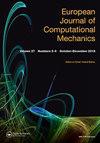Numerical Simulation of Laminar Boundary Layer Flow Over a Horizontal Flat Plate in External Incompressible Viscous Fluid
IF 0.6
Q3 MECHANICS
引用次数: 17
Abstract
In this paper, steady laminar boundary layer flow of a Newtonian fluid over a flat plate in a uniform free stream was investigated numerically when the surface plate is heated by forced convection from the hot fluid. This flow is a good model of many situations involving flow over fins that are relatively widely spaced. All the solutions given here were with constant fluid properties and negligible viscous dissipation for two-dimensional, steady, incompressible laminar flow with zero pressure gradient. The similarity solution has shown its efficiency here to transform the governing equations of the thermal boundary layer into a nonlinear, third-order ordinary differential equation and solved numerically by using 4th-order Runge-Kutta method which in turn was programmed in FORTRAN language. The dimensionless temperature, velocity, and all boundary layer functions profiles were obtained and plotted in figures for different parameters entering into the problem. Several results of best approximations and expressions of important correlations relating to heat transfer rates were drawn in this study of which Prandtl’s number to the plate for physical interest was also discussed across the tables. The same case of solution procedure was made for a plane plate subjected to other thermal boundary conditions in a laminar flow. Finally, for the validation of the treated numerical model, the results obtained are in good agreement with those of the specialized literature, and comparison with available results in certain cases is excellent.外不可压缩粘性流体水平平板层流边界层流动的数值模拟
本文对均匀自由流中牛顿流体在平板上的稳态层流边界层流动进行了数值研究。这种流动是许多情况下的一个很好的模型,这些情况涉及在相对较宽间隔的翅片上的流动。对于零压力梯度的二维稳定不可压缩层流,本文给出的所有解都具有恒定的流体性质和可忽略的粘性耗散。相似解将热边界层的控制方程转化为非线性三阶常微分方程,并用FORTRAN语言编制的四阶龙格-库塔方法进行数值求解,显示了其有效性。获得了无量纲温度、速度和所有边界层函数的轮廓,并将其绘制在进入问题的不同参数的图形中。在这项研究中,得出了与传热率相关的几个最佳近似结果和重要相关性的表达式,其中还讨论了普朗特对板的物理兴趣数。对于在层流中受到其他热边界条件影响的平板,也进行了相同的求解程序。最后,对于处理后的数值模型的验证,所获得的结果与专业文献的结果非常一致,并且在某些情况下与现有结果的比较非常好。
本文章由计算机程序翻译,如有差异,请以英文原文为准。
求助全文
约1分钟内获得全文
求助全文

 求助内容:
求助内容: 应助结果提醒方式:
应助结果提醒方式:


